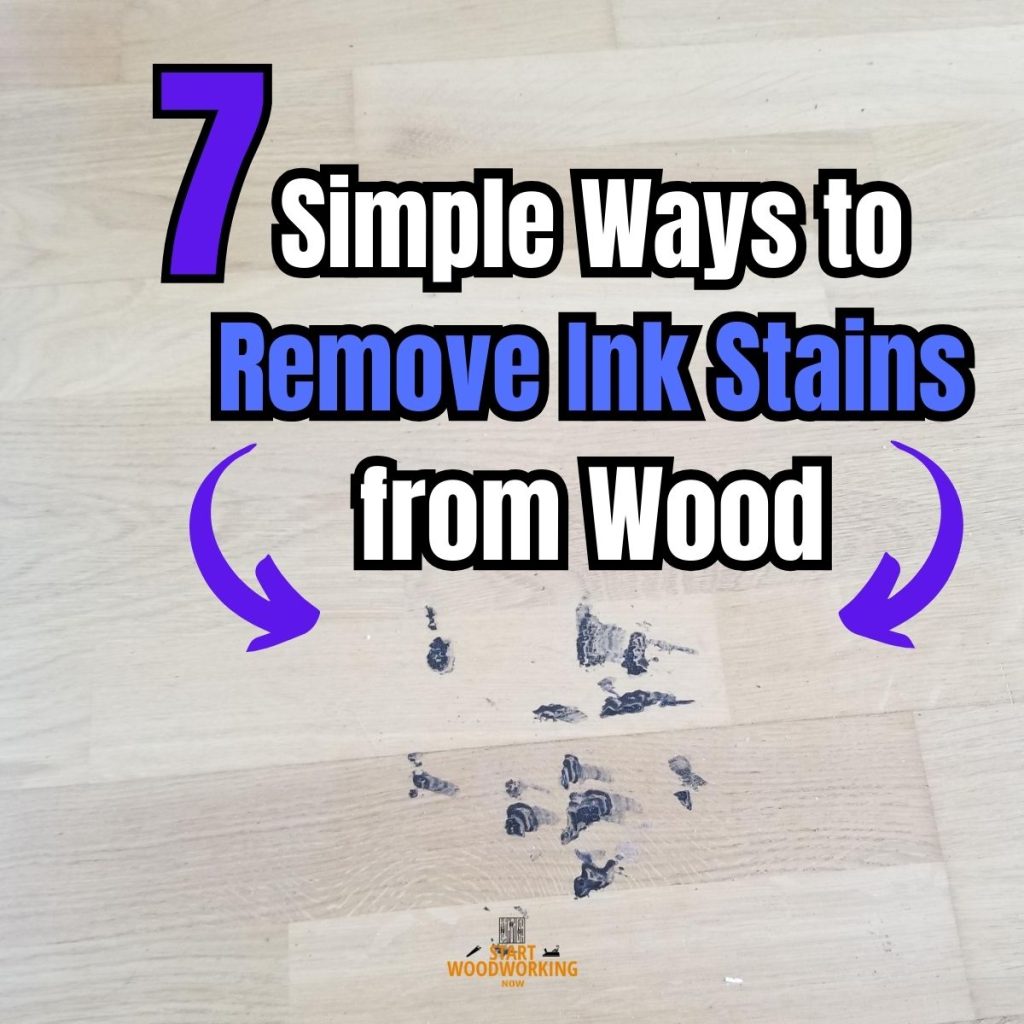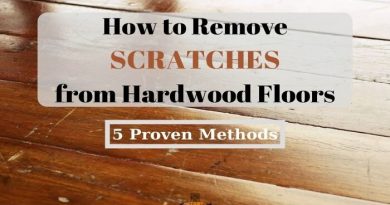7 Simple Ways to Remove Ink Stains from Wood Surfaces
- Prepare the Area: Clean the wood surface with a dry cloth to remove any dust or debris.
- Apply Rubbing Alcohol: Dampen a cotton ball with isopropyl alcohol (rubbing alcohol).
- Blot the Stain: Gently press the cotton ball onto the ink stain. Do not rub; just blot.
- Wipe Off: Use a clean cloth to wipe the wood area, removing the lifted ink.
- Dry: Allow the wood to air dry.
- Polish (Optional): Polish the wood to restore its shine if needed.
Remove Fresh Ink from Wood Surfaces
Method #1. Using Hairspray
- Test the Hairspray: Before starting, I always test the hairspray on a hidden area of the wood to ensure it doesn’t damage the finish. I spray a small amount, let it sit for a minute, then wipe it off and check for any changes in the wood’s appearance.
- Blot the Stain: If the ink stain is fresh, I take a clean, dry cloth and blot any excess ink to prevent it from spreading further. It’s important not to rub, as that can drive the ink deeper into the wood grain.
- Apply the Hairspray: I spray the hairspray directly onto the ink stain, aiming to cover it completely. I let it sit for a few seconds to penetrate the ink. The alcohol in the hairspray acts as a solvent to break down the ink.
- Wipe Gently: After letting the hairspray sit, I use a clean cloth to gently wipe away the stain. The ink should lift off with the hairspray. If the stain persists, I might repeat the application a second time.
- Clean the Wood: Once the ink is removed, I clean the wood area with a damp cloth to remove any residue from the hairspray, then dry the wood thoroughly with a clean, dry cloth.
- Condition the Wood: To finish, I often apply a wood conditioner or polish to nourish the wood and restore its natural luster, especially if the hairspray has dulled the finish.
Pros:
- Readily available household product
- Effective on fresh stains before the ink sets in
- Alcohol solvent breaks down many types of ink
- Non-abrasive method won’t damage wood surface
Cons:
- Repeated applications may dull or damage some wood finishes
- Does not work well on all ink types like permanent marker
- Residue left behind needs thorough cleaning to avoid tackiness
Method #2. Using Mr. Clean Magic Eraser
- Test the Eraser: Before tackling the ink stain, I always test the Magic Eraser on a hidden section of the wood to ensure it doesn’t damage the finish. These erasers can be quite abrasive, so a gentle touch is key. I dampen a corner of the eraser, lightly rub it on the inconspicuous spot, then check for any discoloration or damage.
- Dampen the Magic Eraser: If the test goes well, I lightly wet the Magic Eraser with water. It’s important to squeeze out any excess water because too much moisture can damage some wood finishes or even the wood itself if it’s not properly sealed.
- Gentle Scrubbing: With a light hand, I use the dampened Magic Eraser to gently rub the ink stain. The micro-abrasive surface should start lifting the ink from the wood. I use circular motions and avoid applying too much pressure to prevent wearing through the finish or the wood surface.
- Wipe and Check: After a few gentle passes, I wipe the area with a clean, damp cloth to remove any residue and inspect the stain. If traces of ink remain, I repeat the gentle scrubbing with the Magic Eraser, checking frequently to ensure the wood’s finish remains intact.
- Dry and Condition: Once the ink is removed, I immediately dry the area thoroughly with a soft, clean cloth. To replenish any natural oils that might have been stripped from the wood, I apply a suitable wood conditioner or polish to restore its sheen and protect the surface.
Pros:
- Designed to remove stains without harsh chemicals
- Only requires water for activation
- Gentle scrubbing won’t damage most finishes
- Easy availability at local grocery and hardware stores
Cons:
- Can potentially damage softer wood surfaces
- Over-scrubbing risks wearing down finish or wood grain
- Not as effective on porous, unsealed wood
Method #3. Using Murphy Oil Soap
- Prepare the Solution: I start by diluting Murphy Oil Soap with water according to the instructions on the bottle. This creates a mild cleaning solution that’s strong enough to tackle ink stains but gentle enough not to harm the wood’s finish.
- Test the Cleaner: Before applying the solution to the stained area, I always test it on a less visible part of the wood to ensure it doesn’t cause any discoloration or damage to the finish.
- Blot the Stain: If the ink stain is fresh, I use a soft, dry cloth to blot as much ink as possible. It’s important to dab rather than rub to avoid spreading the stain.
- Apply the Solution: I dip a clean, soft cloth into the Murphy Oil Soap solution and wring it out so it’s damp but not dripping. Then, I gently wipe the stained area, working from the outside of the stain towards the center to prevent the ink from spreading.
- Rinse and Dry: After the ink has lifted, I promptly rinse the area with a cloth dampened with clear water to remove any soap residue, as it can attract dirt if left on the surface. Then, I dry the wood thoroughly with a clean towel.
- Buff the Wood: To restore the wood’s natural luster, I finish by buffing the area with a dry, soft cloth. If the wood looks a bit dull after cleaning, I may apply a wood polish or conditioner to rejuvenate it.
Pros:
- Specifically designed to clean finished wood surfaces
- Mild formula won’t damage most wood finishes
- Lifts stains without harsh scrubbing or chemicals
- Dissolves ink and makes it easier to remove
- Can be applied directly or with a damp cloth
Cons:
- Must be promptly rinsed off to avoid residue buildup
- Not compatible with some waxes and shellac finishes
- Doesn’t work as well on extremely porous woods
Method #4. White Vinegar
- Create a Vinegar Solution: I mix a solution of one part white vinegar to two parts water. Vinegar is acidic, which helps break down the ink, but diluting it minimizes the risk of damage to the wood’s finish.
- Test the Solution: It’s crucial to test the vinegar solution on an inconspicuous area of the wood first. I apply a small amount with a cloth, wait a few minutes, then wipe it off to ensure it doesn’t harm the finish or lighten the wood.
- Blot the Stain: If dealing with a fresh ink stain, I gently blot it with a clean, dry cloth to absorb as much ink as possible without spreading it further.
- Apply the Vinegar Solution: Using a soft cloth, I apply the diluted vinegar solution to the ink stain, dabbing gently. I take care not to soak the wood, as excessive moisture can damage it.
- Wipe and Repeat if Necessary: After a few minutes, I wipe the area with a clean, damp cloth to check if the stain is lifting. For stubborn stains, I might need to reapply the vinegar solution and let it sit a bit longer.
- Rinse and Dry: Once the stain is removed, I rinse the area with a cloth dampened with water to remove any vinegar residue, as it can attract dirt over time. Then, I dry the wood thoroughly with a soft towel.
- Condition the Wood: Finally, I apply a wood conditioner or polish to the cleaned area to nourish the wood and restore its shine, especially since vinegar can sometimes dull the finish.
Pros:
- Mild acetic acid breaks down many types of ink
- Safe for use on most finished wood surfaces
- Removes stains without harsh scrubbing
- Often effective on stubborn stains other methods can’t lift
- Diluted solution minimizes risk of damage to wood
Cons:
- Strong vinegar odor during application
- Acidity can damage some finishes with prolonged exposure
- May dry out or discolor some wood finishes over time
Remove Dried Ink from the Wood Surface
Method #1. Using Baking Soda Paste
- Prepare the Baking Soda Paste: I start by mixing baking soda with water to create a thick paste. The consistency should be similar to toothpaste—solid enough to stay in place but malleable enough to spread over the stain.
- Apply the Paste to the Stain: Using a spatula or an old credit card, I gently apply the baking soda paste directly onto the dried ink stain, being careful to cover it completely. The fine abrasive nature of baking soda helps lift the stain without scratching the wood.
- Let the Paste Sit: I allow the paste to sit on the stain for a few minutes. This gives it time to break down the ink. The paste shouldn’t dry out completely; if it starts to dry, I mist it lightly with water to keep it moist.
- Gently Scrub the Stain: After letting the paste sit, I use a soft-bristled brush or a cloth to gently scrub the area in a circular motion. The goal is to lift the stain without damaging the wood’s finish, so a light touch is essential.
- Wipe Away the Paste: Once the stain has lightened or disappeared, I use a damp cloth to wipe away the baking soda paste, ensuring that all residue is removed from the wood surface.
- Rinse and Dry the Area: I follow up by wiping the area with a clean, damp cloth to rinse off any remaining paste, then immediately dry the wood thoroughly with a soft towel to prevent moisture damage.
- Condition the Wood: To finish, I often apply a wood conditioner or polish to the area to restore the wood’s natural sheen and protect the surface from future damage.
Method #2. Sanding
- Choose the Right Grit: I select a fine-grit sandpaper, usually around 220-grit, to start. A fine grit reduces the risk of creating noticeable scratches or removing too much of the wood’s surface.
- Test Sand an Inconspicuous Area: Before addressing the stain, I test the sandpaper on a hidden part of the furniture or wood to ensure it doesn’t overly mar the finish or the wood.
- Sand the Stain: I gently sand the stained area with the grain of the wood, applying even pressure. The goal is to remove only the topmost layer where the ink has penetrated, preserving as much of the surrounding finish and wood as possible.
- Check Progress Frequently: I frequently check my progress by lightly brushing away the sawdust with a soft cloth. This allows me to see if the stain is lifting without over-sanding the area.
- Wipe Clean: Once the ink stain has been sanded away, I thoroughly wipe the area with a damp cloth to remove all sawdust and debris, ensuring a clean surface for refinishing.
- Refinish the Wood: After the stain is removed and the wood is clean, I apply a matching wood stain or finish to the sanded area, blending it into the surrounding wood to restore the piece’s uniform appearance.
Method #3. Using Mineral Spirits
- Prepare the Area: I ensure the workspace is well-ventilated because mineral spirits emit strong fumes. I also wear gloves to protect my hands and safety glasses to shield my eyes.
- Apply Mineral Spirits: I dampen a clean, white rag with a small amount of mineral spirits. It’s important to use a white rag to prevent any dye transfer onto the wood. I gently blot the stained area with the rag, taking care not to oversaturate the wood.
- Let It Work: I allow the mineral spirits to sit on the stain for a short period, usually a minute or so. This helps to break down the ink.
- Wipe and Repeat if Necessary: Using a clean section of the rag, I wipe the area to see if the stain is lifting. If the stain persists, I repeat the application, allowing the mineral spirits to penetrate a bit longer.
- Clean the Wood: After the stain is removed, I wipe down the entire area with a clean cloth to remove any residue from the mineral spirits. This step is crucial as leftover mineral spirits can affect the wood’s finish over time.
- Dry and Assess: I let the wood dry completely. If the finish looks dull or the wood seems dry, I might apply a wood conditioner or finish restorer to rejuvenate the area and match the sheen of the surrounding wood.
Wood Varieties and Ink Removal Techniques
| Wood Type | Best Method for Fresh Ink Stains Removal | Best Method for Dried Ink Stains Removal |
|---|---|---|
| Softwoods (Pine, Cedar) | Murphy Oil Soap, White Vinegar | Sanding, White Spirit |
| Hardwoods (Oak, Maple) | Baking Soda Paste, Hairspray | Sanding, White Spirit |
| Veneer | Gentle use of Magic Eraser, Lemon | Baking Soda Paste, White Spirit |
| Lacquered Wood | Hairspray, White Vinegar | Professional Restoration |
| Painted Wood | Mild Soap Solution, White Vinegar | Gentle Sanding, Touch-Up Paint |
| Polished Wood | Murphy Oil Soap, Hairspray | Baking Soda Paste, Professional Restoration |
| Unfinished Wood | White Vinegar, Lemon | Sanding, White Spirit |
| Varnished Wood | Hairspray, Magic Eraser | White Spirit, Fine Steel Wool |
| Raw Wood, Untreated Wood | White Vinegar, Lemon | Sanding, White Spirit |
For Varnished Wood, care should be taken when using Magic Eraser as it can potentially dull the varnish. Similarly, for Raw Wood and Untreated Wood, gentle methods are preferred for fresh stains to avoid damaging the natural wood.
Ink Types and Removal Techniques
| Ink Type | Removal Technique for Fresh Stains | Removal Technique for Dried Stains |
|---|---|---|
| Water-Based Ink | White Vinegar, Mild Soap Solution | Baking Soda Paste, Magic Eraser |
| Gel Ink | Rubbing Alcohol, Hairspray | Acetone-based Nail Polish Remover |
| Permanent Ink | Isopropyl Alcohol, Hairspray | White Spirit, Fine Steel Wool |
| Ballpoint Pen Ink | Hairspray, Rubbing Alcohol | Sanding, Professional Restoration |
| Fountain Pen Ink | Salt Solution, Lemon Juice | Baking Soda Paste, Magic Eraser |
| Marker Ink | Isopropyl Alcohol, Hairspray | Acetone, Professional Restoration |




